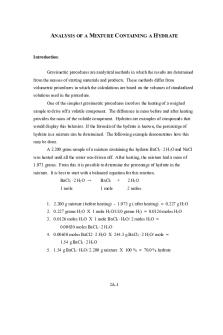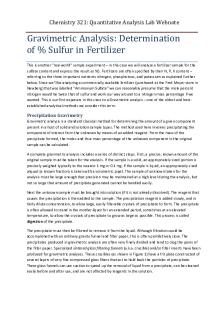Gravimetric Analysis of a Chloride Salt PDF

| Title | Gravimetric Analysis of a Chloride Salt |
|---|---|
| Course | Elementary Chemistry I |
| Institution | Carleton University |
| Pages | 7 |
| File Size | 138.2 KB |
| File Type | |
| Total Downloads | 70 |
| Total Views | 141 |
Summary
Formal Lab...
Description
Gravimetric Analysis of a Chloride Salt Author: Devin Thom Partner: Matthew Vandrop 14/11/2017 CHEM 1005 Tuesday PM, Group H
Purpose The purpose of the experiment was to use gravimetric anayalsis to determine the choride concentration in a unknown salt compound. Theory The intended reaction for this lab is: Ag
+ (Aq)
-
+ Cl
AgCl(S)
(Aq)
Even though AgCl(s) is very insoluble, it is still slightly soluble and thus has a Ksp. The Ksp -
is 1.3 x 10 5 moles per litre. Silver chloride recipes as colloid, with extremely small particles, so by heating up the solution in the presence of nitric acid, this allows the silver chloride to form larger crystals that will not pass through the filter. A small quantity of nitric acid is then added to prevent peptization(reversion back to colloidal state). Factors leading to Unwanted Ions and/or Higher Chloride Ion recovery Due to this reaction having a rapid precipitation, it often leads to the coprecipitation of other ions -
for example weak acids like CO32 . Thus, it is important to carry out the experiment slowly. It is also important to a moderate amount of excess silver but not a large amount to limit the coprecipitation of other ions. As well, failing to wash and/or fully fry the precipitate will cause the results to be too high. Dry silver chloride will decompose into its elements (silver and chloride) in the presence of light. AgCl(S)
Ag(s) + ½ Cl2(g)
This is known as photodecomposition. If this happens in air, the results will be low since chlorine gas will be released during decomposition. If this happens due to an excess of silver -
ions in an aqueous solution, H3O+ and CO3 will also form and the results will be high. 3Cl2(g) + 9H2O(l) + 5Ag+(aq)
5AgCl(s) + 6 H3O+(aq) + CO3-(aq)
Procedure 0.1100g and 0.1000g of the unknown salt was weighed by difference using an analytical balance. Both unknown salts where transferred to two separate 250mL beakers. 100mL of distilled water and 1mL of dilute(6M) HNO 3 was added to each sample, and stirred until the salt samples where dissolved. 23mL of 0.1M AgNO 3 was added to the beaker with the 0.1100g salt and 21mL of 0.1M AgNO3 was added to the 0.1000g salt solution. Both solutions where heated but not boiled. Once the precipitation was complete, the beakers where stored in a dark place (a drawer) for about 7 minutes. Two cooled sintered glass crucibles where than accurately weighed out. Using a vacuum filtration, the two salts solution where individually poured though the weighed sintered glass filter leaving the solid precipitation in the beaker. The remaining precipitate where than washed using several millimeters of 0.01M HNO3. The solution was then poured back through the filtration again including the precipitate. The precipitate was then washed using 0.01M HNO3. The crucible with the precipitate was then removed and the vacuum filtration was cleaned. The crucible with the precipitate was reattached and washed using the HNO3 again. The liquid in the flask attached to the vacuum filtration was than collected into a test tube to see if it was pure HNO3 like it should have been. If not, repeat the washings and check again.
The precipitates where both washed three times using 5mL of Acetone each time. The prcipate still in the crucible was dried in an oven at 110ºC for 30 minutes. The crucible was than weighed and the amount or precipitate formed in each reaction was determined by weighing by difference. Observations Table 1: sample 349 Initial and Final Appearance of the precipitate Initial Appearance Final Appearance
Small white circular crystals Small solid circles. Mostly all together *both precipitates appeared the same
Table 2: Test for completeness and washings Salt Sample(g) 0.1100 0.1000
Precipitate completeness test No more silver chloride forming No more silver chloride forming
Washing Test No turbidity observed
My Data 90.0303g 90.1403g 0.1100g
My Partner 113.2000g 113.8000g 0.1000g
No turbidity observed
Data Table 3: Salt Masses
Starting mass (+/- 0.0001g) Ending mass (+/- 0.0001g) Sample in beaker (+/0.0002g)
Table 4: Oven temperature and cooling/drying times
Temperature in Oven (+/0.2ºC) Drying Time Cooling Time
My Data 107ºC
Partners Data 107ºC
7 Minutes 10 Minutes
7 Minutes 10 Minutes
Table 5: Precipitate masses
Empty Crucible (+/- 0.0001g) Crucible + Sample (+/0.0001g) Dried Sample mass(+/0.0002g)
My Data 30.4990g 30.5925g
Partners Data 30.1800g 30.3200g
0.0935g
0.1400g
Calculations Volume of AgNO3 needed My Sample: V(AgNO3) = (0.1100)(0.5741)/35.5=0.001778901 ÷0.1=0.017789014 L = 0.017789014L x 100mL/1L= 17.789014= 18mL Total= Vol in mL +5= 18+5= 23mL Partner= 21mL % of Chloride in Sample My sample: moles of cl-= moles of Agcl= 0.1100g ÷ 143.2g/mol =0.000768156mol Mass of chloride = 0.000768156 mol x 35.453 g/mol = 0.027215782g Percent of Chloride ion in sample= (0.027215782g/0.1100) x 100= 24.742% Partners sample: moles of cl-= moles of AgCl= 0.1000g ÷143.2 g/mol= 0.000069823 mol Mass of chloride= 0.000069823 mol x 35.43g/mol = 0.002473817g % of chloride ion in sample= (0.002473817g/0.1000g) x 100= 2.474% Average % of chloride ion= (2.474%+ 24.742%)/2= 13.609% % Uncertainty My sample: % uncertainty= (experminetal value-therotical value)/therotical vlue x 100 = (24.742%-57.41%)/ 57.41% x 100 = -51.68%
Partners % uncertainty = (experminetal value-therotical value)/therotical vlue x 100 = 2.474% -57.41%/ 57.41% x 100= -95.69% Average= (-95.69%+-51.68%)/2= -73.69% Precision of results Deviation of results for my sample= -73.69% - (-51.68%)=-22.01% My partners= -73.69%-(-2.474%)=-71.22% Average deviation= -71.22+-22.01/2=-46.62 Relative average deviation(ppt)= (-46.62/-73.69%) x 1000=632.65 ppt Discussion The results are lower than the accepted value possibly because some light most of hit the light during the transfer of the solutions into the drawer causing photodecomposition of AgCl. As well, when checking on if the solutions cooled to enough, more light had to enter the drawer. Another possible explanation could be that some peptization occurred causing some of precipitate to fall through the filter. As well, the solution might not have been heated long enough so there was still small crystals that could pass through the filter. Another possible explanation could simply be the filter wasn’t small enough to keep all of the precipitate from passing through during vacuum filtration. Conclusion The unknown sample number was 349, with an accepted value of 57.41% but the experimental average value was 13.609%. The average percent uncertainty was -73.69% and the Relative average deviation is 632.65ppt....
Similar Free PDFs

Ammonium chloride salt anysis
- 1 Pages

Class XI SALT Analysis
- 10 Pages

8397989 Salt Analysis Chart
- 7 Pages

Exp.1 The Solubility of a Salt
- 7 Pages

P H of Salt Solutions
- 3 Pages
Popular Institutions
- Tinajero National High School - Annex
- Politeknik Caltex Riau
- Yokohama City University
- SGT University
- University of Al-Qadisiyah
- Divine Word College of Vigan
- Techniek College Rotterdam
- Universidade de Santiago
- Universiti Teknologi MARA Cawangan Johor Kampus Pasir Gudang
- Poltekkes Kemenkes Yogyakarta
- Baguio City National High School
- Colegio san marcos
- preparatoria uno
- Centro de Bachillerato Tecnológico Industrial y de Servicios No. 107
- Dalian Maritime University
- Quang Trung Secondary School
- Colegio Tecnológico en Informática
- Corporación Regional de Educación Superior
- Grupo CEDVA
- Dar Al Uloom University
- Centro de Estudios Preuniversitarios de la Universidad Nacional de Ingeniería
- 上智大学
- Aakash International School, Nuna Majara
- San Felipe Neri Catholic School
- Kang Chiao International School - New Taipei City
- Misamis Occidental National High School
- Institución Educativa Escuela Normal Juan Ladrilleros
- Kolehiyo ng Pantukan
- Batanes State College
- Instituto Continental
- Sekolah Menengah Kejuruan Kesehatan Kaltara (Tarakan)
- Colegio de La Inmaculada Concepcion - Cebu










